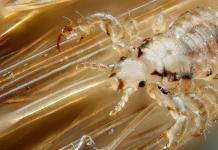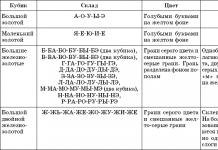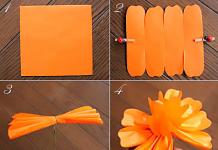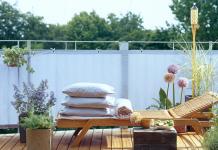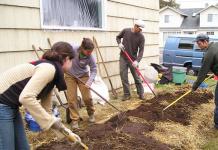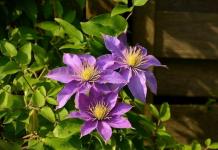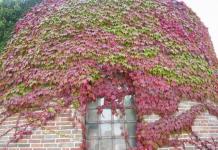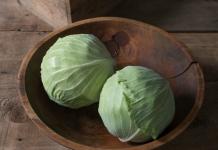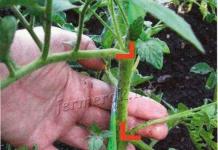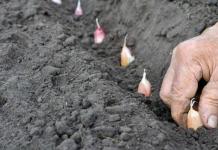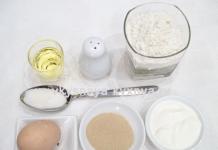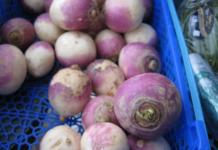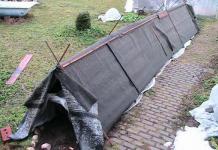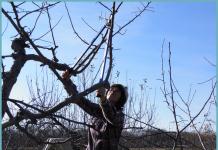For many trees and shrubs, green cuttings are one of the most productive methods of vegetative propagation. In June - early July, when the plants are in the active growth phase, the best time for green cuttings comes.
With the help of green cuttings, many trees and shrubs can be propagated, but it must be borne in mind that the rooting ability of cuttings depends on the type and variety of the plant.
The method of propagation by green cuttings is based on the ability of stem cuttings to form adventitious roots, which is expressed to varying degrees in different plants. The greatest differentiation ability is possessed by evolutionarily younger herbaceous perennials and shrubs, to a lesser extent - tree species, especially the most ancient conifers in origin, although among them there are species with a high capacity for rooting by green cuttings. Vines (clematis, grapes, maiden grapes, actinidia, petiolate hydrangea), many shrubs (mock-mushrooms, lilacs, hydrangeas, privet, honeysuckle) are easily rooted. For roses, it is advisable to use cuttings only for small-leaved groups, the main assortment of varietal roses grows better and hibernates on the rootstock.
The process of formation of adventitious roots on cuttings begins with the formation of callus as a reaction to injury. Callus gives cuttings resistance to adverse environmental conditions and the penetration of infections. Callus formation is most pronounced in hard-to-root plants.
Harvesting cuttings
Green cuttings are leafy parts of the stem with one or more buds. It is preferable to take cuttings from young plants; very old mother plants are preliminarily subjected to rejuvenating pruning. The best material for cuttings are lateral shoots that form on last year's growths in the lower, but well-lit part of the crown, which have large developed buds and do not carry signs of disease. Upright shoots as well as ankle tops will take less root, as they do not contain enough carbohydrates for successful rooting.
In the process of harvesting cuttings, it is important to ensure the preservation of moisture in the tissues, on which the success of rooting largely depends. Shoots are cut early in the morning when all plant tissues are saturated with moisture. At all stages of working with cuttings, they should not be allowed to dry out; cut shoots should be immediately placed in the water in the shade. Cutting cuttings start as quickly as possible. If transportation is required, cuttings, without spraying with water, are placed obliquely in a container with wet sphagnum. In such packaging, they can be stored in the refrigerator, but the total storage duration should not exceed 2 days.
Cuttings are cut 8-12 cm long with two or three internodes; plants with short internodes may have more. In a number of plants - roses, rhododendrons, hydrangeas, grapes, mock orange, lilac cuttings with one axillary bud, called leaf buds, take root well. Such cuttings make it possible to obtain a large amount of planting material of valuable species and varieties with a small amount of material for cuttings. When propagating by cuttings at the optimum time, it is better to use the middle and lower ones, and in the later periods - the upper part of the shoot. Cutting is done on a hard board with a very sharp tool - a grafting knife or a blade that does not squeeze the tissue. The lower cut is made oblique to increase the suction surface, 1 cm below the kidney, the upper cut is straight, directly above the kidney. In large-leaved plants (for example, lilac, viburnum, vesicle), to reduce the evaporation area, the leaf blades are cut by ½ or 1/3, but in difficult-to-root, as well as variegated, yellow-leaved, purple forms with a low chlorophyll content, this technique should be used carefully, since assimilation may not be sufficient to ensure root formation. Truncation of leaf blades would be good to do even on the eve of cutting the cuttings, this will also reduce moisture loss. The cuttings are sprayed with water and placed under a non-woven covering material before planting to prevent them from withering.
To increase the effectiveness of rooting, simple techniques are used: incising the bark near the buds by 2 mm, bending the branches, banding with copper wire or etiolating the shoots. All these measures help to prevent the outflow of carbohydrates and growth substances - auxins from the shoots. Etiolation is carried out by tying the shoot with foil, paper or black non-woven material 2-3 weeks before grafting. In the shoot, a redistribution of metabolism occurs and the effectiveness of rooting increases.
Methods to improve rooting efficiency
It is known that the process of root regeneration is regulated by growth substances - auxins, carbohydrates and nitrogenous substances. In many species and varieties, under the influence of growth regulators, the percentage of rooting cuttings, the number of roots, the quality of plants increase, and the rooting time is reduced. Some hard-to-root crops become easily rooted, but sometimes, depending on the biological characteristics of a particular species or variety, there may be no response to stimulants.
Good root stimulants are:
Heteroauxin (indoleacetic acid (IAA)) - from 50 to 200 mg / l,
Kornevin (indolylbutyric acid (IMA)) - 1 g / l of water,
Zircon (a mixture of hydroxycinnamic acids) - 1 ml / l of water.
Treatment with stimulants should be done in the dark, at a temperature of + 18 ... + 22 degrees. The cuttings are immersed in the solution so that the leaves are not processed. The concentration of the solution and the exposure time must be kept exactly, exceeding them may lead not to an increase in the effect, but to a toxic effect. Therefore, it is better to use Kornevin in a solution and maintain a strict exposure for 16-20 hours, and not dust the cuttings with it.
Planting cuttings
Ready cuttings are planted in pre-prepared spreading ridges, which are arranged in the shade (in most cases, the optimal illumination for successful rooting is 50-70%). Rooting proceeds best when the substrate temperature is 3-5 degrees higher than the ambient temperature. To create such conditions, biofuel is laid at the bottom of the ridge - horse manure with a layer of 25-30 cm, which, decomposing, generates heat and provides the cuttings with lower heating. Next, a fertile soil is poured with a layer of 15 cm, and finally, a substrate for rooting with a layer of 3-4 cm.As such a substrate, you can use a mixture of neutral peat with sand in a ratio of 1: 1 or 2: 1 with the addition of finely chopped sphagnum moss, which has moisture retaining and bactericidal properties. It is useful to shed the substrate with one of the drugs - Radiance, Baikal, Renaissance, Fitosporin to suppress pathogenic microflora. The same preparations can be used in the process of caring for cuttings, adding to the irrigation water once every 1-2 weeks.
Cuttings are planted at a distance of 5-7 cm from each other to a depth of 1.5-2 cm. On top of the ridge is covered with glass, plastic wrap or non-woven covering material in arcs at a height of 25 cm from the cuttings. Each of these materials has its own drawbacks - in the heat, under polyethylene and glass, the temperature can rise too much, and it is more difficult to maintain high humidity under non-woven covering material. For most tree and shrub species, the optimum temperature is + 20 ... + 26 degrees and humidity 80-90%. In an industrial environment, moisture is maintained by fogging machines that spray moisture at regular intervals. At home, cuttings are sprayed with water several times a day. Cuttings should be regularly inspected, and fallen leaves and loose specimens should be removed.

With the beginning of rooting, the plantings are aired, opening the film first for 1-2 hours, each time increasing the time, the number of sprays is reduced. After hardening the rooted cuttings, the film is removed. A month later, they are fed with a liquid complex mineral fertilizer.
A small number of cuttings can be rooted in boxes by adding 8-10 cm of soil and 1.5-2 cm of river sand. 1-3 cuttings can be rooted in a pot by covering with a clear cut-bottom plastic bottle. Removing the cap from the neck, it is convenient to ventilate. It is convenient to move pots or boxes with rooted cuttings for the winter to the basement for the winter.
Cuttings rooted in the cuttings are left in the ground, covered with a dry leaf for the winter, or they are dug up and stored in the refrigerator or dug in the basement, at a temperature of + 1 ... + 2 degrees.
In the spring, the cuttings are transplanted into the "school" for 2-3 years for growing, then transplanted to a permanent place.
The table shows data on the effectiveness of green cuttings in different crops *:
|
Type of plant |
Cuttings harvesting period |
Rooting temperature |
Rooting percentage |
Duration of rooting, days |
The need for stimulants of root formation |
|
|
polyanthus, climbing small-leaved, patio, miniature |
Budding - beginning of flowering (semi-lignified cuttings) |
on average, 83.9%, in some varieties up to 100% |
from 10-15 to 28 |
|||
|
Common lilac: Early varieties Late varieties C. Hungarian S. Wolf C. hairy S. Zvyagintseva |
Fading phase Flowering phase Fading, but not stopping the growth of shoots |
IMK 25-50 g / l |
||||
|
Clematis |
Budding - the beginning of flowering (cuttings from the middle part of the shoot) |
40-100% depending on the grade |
IMK 25-30 g / l, 12-24 h |
|||
|
Chubushnik |
Attenuation of shoot growth - the beginning of flowering |
|||||
|
Spring flowering species Summer flowering species |
Beginning - ser. VI Con. VI - mid. Vii |
from 30 to 100% for different species |
IMC 25-100 g / l increases rooting by 10-15% |
|||
|
Forsythia |
F. ovoid |
Attenuation of shoot growth (first half of VI) |
||||
|
K. ordinary "Roseum" (Buldenezh) K. gordovina |
Mass flowering period |
IMK 25-50 g / l or heteroauxin 50-100 g / l |
||||
|
Cotoneaster |
K. brilliant K. horizontal |
Con. VI - early. Vii |
||||
|
D. rough |
Beginning VI - mid. Vii |
0.01% BCI, 16 h |
||||
|
Privet |
B. ordinary |
Ser. VI - early. Vii |
||||
|
D. male D. offspring |
||||||
|
Honeysuckle |
J. offspring J. Hekroth J. Tatar J. blue (F. edible) |
End of shoot growth |
||||
|
Hydrangea |
G. paniculata G, tree-like G. Bretschneider G. petershkovaya |
Responsive to IMC |
||||
|
Rhododendron |
R. pontic R. katevbinsky R. Japanese |
IMC 50 mg / l Powder. 2% IMC 0.005% BCI, 17 h |
||||
|
Actinidia |
A. acute A. kolomikta |
|||||
|
C. tannery |
Con. VI - early. Vii |
Experienced Khabarovsk gardener Lyudmila Saksina is cutting roses in August. To do this, she makes an original and cheap cuticle from a plastic bottle.
The summer resident takes a five-liter bottle and cuts off the top from it in the place where the bevel begins. Cuts not completely - on one side, the top remains connected to the bottom. Folds back and starts filling.
At the bottom of the bottle, he puts 5 cm of drainage: small pebbles or expanded clay. Then he pours 5 cm of sand, then good nutritious soil with humus, and again as much sand on top as necessary to deepen the cutting.
The stalk must be placed at an angle so that its lower end is on the surface of the nutrient layer, but does not go deep into it, but on top - in the sand. This is necessary so that when the roots come out of the lower bud, they are immediately in the nutrient medium. And the sand from above will tightly support the cutting and prevent it from rotting.
The cuttings filled with cuttings of roses are watered from a watering can. Then Lyudmila Zakharovna covers the lower part of the upper bottle - the one that was cut and bent to the side. Coats the cut with tape so that excess air does not penetrate and does not dry the cuttings. Screws the cork and places the cuticle bottle in the shade, between the peony bushes. “And I don’t drop by for two or three weeks,” says the summer resident.
In the fall, Lyudmila Saksina lowers the bottle with rooted roses into the basement, only unscrews the lid so that fresh air comes in, otherwise they will become moldy.
During the winter, the leaves will fall off, but the bushes themselves will be alive and well. In the spring, the summer resident brings them into a warm room and puts them on the glassed-in balcony. At the same time, the bottle is cut off. Roses quickly grow overgrown with young foliage. And with the onset of warmth, they can be planted in the garden.
This cuttings can also be used to grow other shrubs. It is also convenient because in one bottle you can draw a plant of the same type and variety. Sticking the label with the name directly to the bottle with scotch tape - you can't confuse it anymore.
Another plus of such a handle was explained by Lyudmila Saksina herself:
“Our scientists concluded: the smaller the distance from the cover to the cuttings, the better they take root. And why? But because closer to the shelter there is more moisture that accumulates on the walls of the shelter. In my experience, this is about 20 cm from the lid. "
How to cut rose cuttings
It is better to cut the cuttings before the flowering of the rose shoot, when the buds have just become colored. Then the rooting will be amicable. If you cut the cuttings later, the percentage of rooting is reduced and the rooting itself takes longer.
A shoot is cut from a bush, and then cuttings with three buds are cut from its middle part.
At the same time, an oblique cut is made under the lower kidney of the cutting (at an angle of 45 degrees), and a straight cut is made above the upper kidney.
The lower leaf of the cutting is removed completely, and the upper leaves are shortened to 1/3 of the surface.
The desire of flower growers to get new varieties of roses on their own, or to quickly propagate decorative varieties, is quite understandable. The easiest way to propagate rose bushes is by cuttings. But novice flower growers and experienced masters, when growing roses by cuttings, always ask themselves a far from idle question: "How to do it right?"
All varieties of ground cover and miniature roses, polyanthus and climbing roses with small flowers are ideal for cuttings. The survival rate of floribunda cuttings is approximately 50% of the total number of planted plants.
 Cuttings prepared for rooting
Cuttings prepared for rooting Large-flowered varieties of climbing roses, park and hybrid tea varieties are difficult to cut. When propagating these plants, you can fail, the yield of established cuttings is extremely small.
Tip: Large-flowered decorative varieties of roses with yellow flowers are not suitable for cuttings. Such cuttings root poorly, and those that have taken root develop a weak root system. In this case, it is better to use grafting propagation of the variety.
Cutting rose bushes in summer: methods and benefits
Summer cuttings use green cuttings, which appear in abundance on mother rose bushes, so choosing the right ones is not difficult.
The cuttings of roses planted for rooting in the warm season manage to take root until autumn, get stronger and do not give the grower any special difficulties during wintering.
 Cuttings of roses
Cuttings of roses Several methods of summer cuttings of rose bushes are practiced. Usually it is carried out 2 times during the spring-summer period:
- April-May (in the greenhouse);
- June-July (outdoors).
Planting rose cuttings outdoors
The best results are obtained by summer cuttings of roses in greenhouses. In a greenhouse, it is easier to monitor the rooting of cuttings, their condition, the need for watering, the development of diseases, and so on.
It is allowed to plant cuttings directly in open ground. First, it is necessary to prepare a suitable soil mixture for rooting cuttings, which is used to fill the allotted beds.
 Rose cuttings treated with growth stimulant
Rose cuttings treated with growth stimulant A suitable nutrient composition should include:
- Leafy land.
- Coarse river sand (can be used in a mixture with peat 50:50).
- Sod land.
- Vermiculite or perlite.
The mixture is made up in a ratio of 2: 1: 2: 0.5.
Advice. It is useful to cover the surface of the prepared soil with a layer of coarse sand about 3 cm high, this will prevent possible stagnation of water during excessive watering and improve drainage.
The finished soil substrate must be shed with a pink solution of potassium permanganate; when rooting cuttings, you can use root formation stimulants: "root", "epin", "heteroauxin".
Requirements for cuttings
Cuttings for rooting are selected from healthy mother plants, they are cut into a length of 10-15 cm. At the same time, at the bottom, an oblique cut is made directly under the kidney, and at the top - at a distance of 0.5 mm above the kidney. The lower leaves on the cuttings are removed completely, the upper ones are shortened by half.
Important! Cuttings that are cut from fattening green shoots are not suitable for rooting.
In the prepared soil, the cuttings are planted obliquely, at an angle of 45 degrees, while they are not buried in the soil by more than 10 cm.
Cuttings are covered with foil to maintain moisture. Caring for planted pink cuttings consists in timely watering and airing the plantings, maintaining high humidity, periodic examinations for pests and possible diseases.
 Cuttings are prepared only from healthy and strong plants
Cuttings are prepared only from healthy and strong plants Young rose bushes will remain in the beds for the winter, so a safe shelter from frost should be provided. In a permanent place, roses can be planted next spring.
Rose bushes from a bouquet - it's possible!
Bouquets of roses received in summer as a gift can serve as breeding material for the variety, while it should be noted that the most successful results are obtained when rooting local, adapted roses.
Bouquet roses are kept in a vase until the petals completely fall off, changing the water daily and cutting off the tips of the stems.
Advice! The stems of roses suitable for grafting must have healthy, intact buds and a thickness of 0.5 mm or more.
Cuttings with one or two buds are cut from the middle part of the shoots. It is allowed to plant cuttings with one bud, which, when planting, is buried to ground level. Leaves on the shoots are significantly shortened or removed.
 You can even root a rose from a bouquet for planting in open ground
You can even root a rose from a bouquet for planting in open ground Cuttings are planted in a shady place in a pre-prepared bed, the top is covered with a film (if there are many cuttings) or plastic bottles with a cut off the bottom.
Advice! Do not remove the neck with a stopper from the plastic bottle, this hole can serve for ventilation of landings.
In spring, young rose plants can be planted permanently in the garden.
Autumn breeding of roses
For autumn propagation of roses, lignified, well-ripened annual shoots, at least 5 mm thick, are used, which are in sufficient quantity after pruning rose bushes for the winter.
Prepared cuttings with removed leaves are tied in bunches and stored until spring in a moist substrate of sand and peat. The storage temperature of the cuttings should be kept within zero degrees. By the end of winter, cuttings of roses form a callus, which contributes to the rapid rooting of rose bushes in spring.
 Callus on cuttings of roses
Callus on cuttings of roses Florists also practice this method of rooting roses in the autumn: cut cuttings are planted obliquely in an open bed, over which they build a shelter from winter frosts. In the spring, the garden bed is opened and the growing of rose bushes continues in natural conditions. Plants are transplanted to a permanent place next fall.
The choice of one or another method of cutting roses depends on the grower, growing conditions and the amount of planting material. Regardless of the chosen method of rooting roses, by cuttings you can easily and quickly get ornamental plants for the garden.
How to root roses from a bouquet: video
What is a stalk, knows, perhaps, every person who is fond of breeding garden and home crops. A cut is a detached part of a plant, for example, a shoot or a leaf, and cuttings are vegetative propagation with its help.
Plants are able to reproduce not only sexually, but also asexually, also called vegetative, and cuttings are most often used for vegetative production of new plants.
In fact, getting new plants from cuttings is a kind of cloning of the original culture. With the help of cuttings, you can quickly and inexpensively increase your garden or home collection.
[!] A definite plus of vegetative reproduction is the inheritance of all the qualities of the mother plant. This is especially important for valuable varietal specimens. In the case where seeds are used, varietal qualities may be lost.
Different types of cuttings are used for propagation. Cuttings are stem and leafy. Stems are used most often, only some plants reproduce with leaves: cacti and other succulents, saintpaulias, gloxinia and some types of begonias.
Leafy cuttings can be:
- whole with petioles,
- whole without petioles,
- fragment of the sheet.
Stem cuttings can be conditionally divided into several types:
- grassy green,
- semi-lignified,
- lignified.
Young growing shoots with a soft stem are called herbaceous or green cuttings. With age, the shoots lose their elasticity and begin to become covered with bark, becoming at first semi-lignified, and then lignified.
Floral plants (chrysanthemums, dahlias, asters) are usually propagated by green cuttings, and rooting occurs very quickly, and the percentage of rooted cuttings is quite high. For propagation of trees and shrubs, semi- and lignified cuttings are most often used.
The table below provides information on the optimal maturity stage of tissues (wood) for rooting stem cuttings of individual ornamental shrubs and trees.
By location, the cuttings are divided into
- apical,
- stem,
- basal.
Usually, part of the stem is cut into cuttings from the middle, but sometimes the top with several leaves is also taken.
Apical and stem cutting
A root cut is obtained from a shoot growing from a root.
The length of the cuttings can also vary. There are single-bud and multi-bud cuttings. One-buds, as the name implies, contain a single bud or leaf and stand out for their very short size. Such cuttings are used when there is a shortage of planting material and the reproduction of easily rooted plants (grapes, raspberries, currants). Multi-bud cuttings are much longer and have several nodes and internodes.
[!] A node is a section of a stem on which buds, leaves, new shoots and other lateral organs are formed. An internode is a segment between adjacent nodes.
 Nodes and internodes on the handle
Nodes and internodes on the handle Sometimes the cutting is cut with a piece of root or bark. Such cuttings are called combined. They can be planted directly in open ground, bypassing the intermediate stages: they take root and take root well. Combined cuttings are
- with a heel,
- with a crutch.
A heel is a piece of root or bark with a thin layer of wood. The heel is obtained when the shoot is not cut off, but broken out from the base. The crutch is a fairly large segment of last year's escape.
 Shank with crutch and heel
Shank with crutch and heel The only drawback of combined cuttings is their limited number. However, if grafting is carried out in small volumes, there will be enough planting material.
How to plant cuttings
Of course, the rooting of each plant has its own subtleties, familiar to experienced gardeners and florists. However, there are general rules, the observance of which, if not guaranteeing a 100% result, will bring it closer to ideal.
Dates of cuttings and the choice of mother plants
The timing of harvesting cuttings largely depends on their maturity. You should cut off not too young, but not old shoots. Their readiness can be determined by the elasticity of the tissues: the stem should be springy without breaking when bent.
For harvesting cuttings, it is important to choose the right time of year. So, green herbaceous shoots are cut, as a rule, in the spring, during the period of active vegetation of the plant, semi-lignified cuttings are best harvested in late summer or early autumn, when active growth stops. Lignified cuttings are usually cut in late autumn and winter. This division is very arbitrary. The timing of cuttings is very dependent not only on the season, but also on the rooting rate of the culture. Easily rooted plants can be propagated by cuttings almost all year round, and difficult-to-root plants only during the period of active growth of shoots.
[!] Based on practice, the optimal average period for propagation of most crops in the middle zone of the European part of Russia begins on June 10 and ends on June 25.
If the spring was long and cold, the timing may move further, and vice versa, in a warm year with early spring, the timing of cuttings moves to the end of May.
You should not harvest cuttings during budding, flowering and ovary formation, because during this period, the plant spends all its strength on future fruiting. It is better to start cuttings before flowering or postpone for several weeks. If only flowering branches are at hand, all flower buds should be carefully removed.
It is not only the time of the year that matters, but also the time of day. It is best to cut the cuttings in the early morning, when the amount of water in the plant is at its maximum, and the weather should be cool and damp if possible.
It is equally important to choose a suitable mother plant. It must be healthy and old enough. Rooting is very negatively affected by viral and fungal diseases, as well as a deficiency of minerals in the mother liquor. As for the age, both too young and too old specimens are not suitable. Taking planting material from a young plant, you can damage it too much. At the same time, in an overly old plant, all life processes are slowed down, so the shoots will root very poorly.
It often happens that cuttings are harvested long before planting. You can save the planting material in a cool dark place, for example, in a plastic bag, in the refrigerator.
Rooting and planting cuttings
So, the time has come, the plant has been selected, you can start grafting. To do this, you will need:
- Garden shears or knife
- Mini greenhouse (or variations thereof)
- Substrate
- Fine atomizer
- Growth regulators

First of all, separate the stalk from the mother plant... Using a sharp knife or pruning shears, disinfected in an alcohol solution, cut off part of the selected shoot. Pay attention to the lower cut - for more active root formation, it is better to do it at an angle. The upper cut, if the cutting is taken from the middle of the shoot, can be straight.
Leaves should be removed from the bottom of the cutting, leaving two or three on top. You do not need to completely get rid of the leaves, they are involved in the process of photosynthesis, thanks to which the plant produces vital nutrients. Too large leaf plates can be cut in half or neatly rolled into a tube.

Cuttings of plants that produce milky sap should be placed in water for several hours. This is necessary in order to flush away any liquid that may interfere with root formation. The thickened shoots of cacti and succulents must, on the contrary, be slightly dried up - slightly dried in the open air.
For roots to appear faster, the bark of the cutting can be slightly cut or scratched. Also, with a sharp disinfected knife, you should remove the kidney located near the cut.

For a more successful rooting of the cuttings, many gardeners and florists use a variety of preparations, the so-called growth regulators... Various studies have shown that under the influence of growth regulators, the process of root formation is much accelerated. These drugs are used, as a rule, only on hard-to-root plants.
Growth regulators come in various forms and are used as follows:
- Powdered - the lower part of the cutting is powdered or dipped into powder.
- Pasty - using a wooden spatula, a thin layer of paste is applied to the lower cut of the cutting.
- Water solutions - cuttings are immersed for a long time (about 12 hours).
- Alcohol solutions - the cuttings are immersed for a few seconds.
In amateur gardening, the following growth regulators are most often used: Heteroauxin, Kornevin, Krezatsin, Zircon, Epin.
[!] Many experienced gardeners advise to powder the cut of the cuttings with activated carbon before planting. Coal, although it does not stimulate the emergence of new roots, perfectly disinfects the shoot, preventing the appearance of rot.
Next step - preparation of a mini greenhouse... Many ready-made and very convenient home greenhouses are now sold, consisting of a pallet, removable cassettes and a transparent cover. There are even electrical options with bottom heating and lighting. However, if there is no opportunity to purchase a compact greenhouse, containers that can be found in every home are quite suitable: a cake container or any deep enough plastic container, PET bottles with a cut-off neck, and finally, ordinary pots for home flowers.
The selected greenhouse must be filled with a suitable substrate. The substrate for growing cuttings must be clean, nutritious and sufficiently loose. Most often, gardeners use a mixture of peat and sand in equal proportions. Peat provides moisture capacity and nutritional value of the soil, sand - good aeration (water and air permeability).
Other ingredients are often added to the soil mixture: sphagnum moss, perlite, vermiculite, expanded clay. Moss perfectly loosens the earth, and also has an antibacterial effect, perlite is absolutely sterile, vermiculite perfectly absorbs and gives off moisture. All of these materials can be mixed with the substrate or used as a drainage layer, which should be at least a quarter of the total volume of the dish.
After you fill the greenhouse with soil, thoroughly moisten the soil with a spray bottle, with a pencil or any other wooden stick, make shallow holes in it, put the prepared cuttings there, deepening them by about a third, and carefully compact the substrate around the stem. Cover the greenhouse with a lid or, if not available, a plastic bag.

[!] Cuttings of some plants can be rooted in water. In the aquatic environment, unpretentious fast-growing species easily take root. Water for germination must be boiled; for disinfection, you can add a couple of crushed activated carbon tablets to it.
Care of cuttings
Further care of the shoots is no less important than proper planting. For successful rooting, it is important
- temperature,
- lighting,
- humidity.
Temperature. The heat demand for different types of plants is not the same. For example, gooseberry cuttings root perfectly at 18 ° С, currants, raspberries and sea buckthorn - at 24 ° С, apple, cherry, apricot - at 24 ° С. Among the decorative indoor crops, ivy is considered the most seasoned, and the most thermophilic are camellia, begonia,. The vast majority of plants take root in warmth, and the average temperature is at least 23 ° C. If the temperature is slightly below optimal, the roots will appear a little later.
Lighting... Lighting, like temperature, should be sufficient, but not excessive: cuttings are best rooted in partial shade. Too intense sunlight can cause burns, and in the shade, the process of photosynthesis will slow down and the cutting will not receive enough nutrients.
Humidity... Cuttings root much better in high humidity conditions. In order for the moisture to be sufficient, the seedlings need to be watered and sprayed from time to time. Watering should be done as the topsoil dries out, and sprayed every day, or at least every other day. After the first roots appear, the amount of moisture must be reduced.
In conditions of high temperature and humidity, pathogenic bacteria and fungi often develop, causing various phyto-diseases: gray rot, powdery mildew, leaf spot. In the fight against them, special preparations sold in gardening stores will help: foundationol (,), cuprozan (anthracnose).
Young seedlings can also attack pests: aphids, nematodes. Usually it is enough to remove them mechanically and rinse the leaves with shoots under running water. In case of severe damage, insecticidal formulations can be used.
From time to time, the lid or bag from the greenhouse must be removed, arranging ventilation. This is a necessary procedure, due to which the plant is hardened, and excess moisture evaporates, which prevents the development of fungal infections. Airing should be regular and frequent, but short in time: young seedlings should be opened for 5-10 minutes 1-2 times a day. As the cuttings grow, the duration of airing should be increased, and then the cover from the greenhouse should be completely removed.
After the cuttings take root and start growing, they need to be fed. Initially, the seedlings require enhanced phosphorus nutrition, later nitrogen comes to the fore.
Unusual ways of rooting cuttings
Above you learned about the classic rooting of young seedlings, but gardeners have tried other, more exotic techniques. The cuttings are rooted:
- in potato tubers,
- in a decoction of willow branches,
- in peat tablets.
To germinate a seedling in a potato, take a large healthy tuber, carefully remove all the eyes, stick a stalk into it, bury it in the ground and cover it with a plastic bag. Further care is the same as for cuttings in a conventional substrate: watering, spraying and airing. It is believed that a large amount of nutrients, especially starch, contribute to the successful rooting of the seedling.
To make a willow broth, you need to cut willow shoots, add water, boil and boil for 5-10 minutes. The resulting broth must be cooled and filtered. After that, seedlings in need of rooting can be placed in it.
Peat tablets are peat or coconut fiber compressed into a small washer. The tablets are poured with water to swell, and then prepared cuttings are inserted into them. Such a substrate has undoubted advantages - sterility, water and air permeability, nutritional value.
Cuttings should be grown in strict compliance with the technology, but, for sure, everyone knows that plants, like other living things, respond to affection and goodness. Plant shoots with love and in a good mood - they take root well, grow quickly and will delight you for many years.
Green cuttings in August. Video lessons. Green cuttings are one of the most productive methods of vegetative propagation. In July - early August, when the plants are in the active growth phase, the best time for green cuttings comes.
With the help of green cuttings, many trees and shrubs can be propagated, but it must be borne in mind that the rooting ability of cuttings depends on the type and variety of the plant. The method of propagation by green cuttings is based on the ability of stem cuttings to form adventitious roots, which is expressed to varying degrees in different plants. The greatest differentiation ability is possessed by evolutionarily younger herbaceous perennials and shrubs, to a lesser extent - tree species, especially the most ancient conifers in origin, although among them there are species with a high capacity for rooting by green cuttings. Vines (clematis, grapes, maiden grapes, actinidia, petiolate hydrangea), many shrubs (mock-mushrooms, lilacs, hydrangeas, privet, honeysuckle) are easily rooted. For roses, it is advisable to use cuttings only for small-leaved groups, the main assortment of varietal roses grows better and hibernates on the rootstock.
Cuttings are cut 8-12 cm long with two or three internodes; plants with short internodes may have more. In a number of plants - roses, rhododendrons, hydrangeas, grapes, mock orange, lilac cuttings with one axillary bud, called leaf buds, take root well. Such cuttings make it possible to obtain a large amount of planting material of valuable species and varieties with a small amount of material for cuttings. When propagating by cuttings at the optimum time, it is better to use the middle and lower ones, and in the later periods - the upper part of the shoot. Cutting is done on a hard board with a very sharp tool - a grafting knife or a blade that does not squeeze the tissue. The lower cut is made oblique to increase the suction surface, 1 cm below the kidney, the upper cut is straight, directly above the kidney.
In large-leaved plants (for example, lilac, viburnum, vesicle), to reduce the evaporation area, the leaf blades are cut by ½ or 1/3, but in difficult-to-root, as well as variegated, yellow-leaved, purple forms with a low chlorophyll content, this technique should be used carefully, since assimilation may not be sufficient to ensure root formation. Truncation of leaf blades would be good to do even on the eve of cutting the cuttings, this will also reduce moisture loss. The cuttings are sprayed with water and placed under a non-woven covering material before planting to prevent them from withering.
Ready cuttings are planted in pre-prepared spreading ridges, which are arranged in the shade (in most cases, the optimal illumination for successful rooting is 50-70%). Cuttings are planted at a distance of 5-7 cm from each other to a depth of 1.5-2 cm. On top of the ridge is covered with glass, plastic wrap or non-woven covering material in arcs at a height of 25 cm from the cuttings. Each of these materials has its own drawbacks - in the heat, under polyethylene and glass, the temperature can rise too much, and it is more difficult to maintain high humidity under non-woven covering material. For most tree and shrub species, the optimum temperature is + 20 ... + 26 degrees and humidity 80-90%. Cuttings rooted in the cuttings are left in the ground, covered with a dry leaf for the winter, or they are dug up and stored in the refrigerator or dug in the basement, at a temperature of + 1 ... + 2 degrees. In the spring, the cuttings are transplanted into the "school" for 2-3 years for growing, then transplanted to a permanent place.










